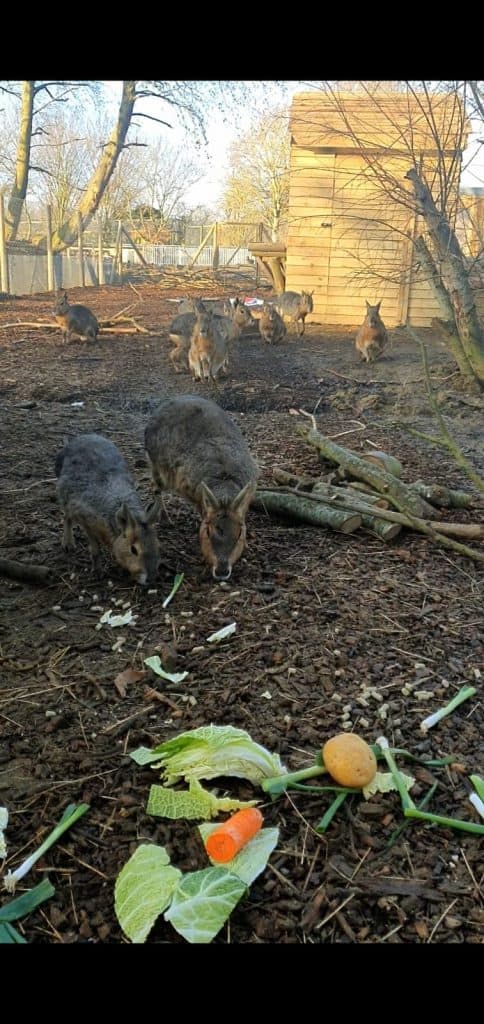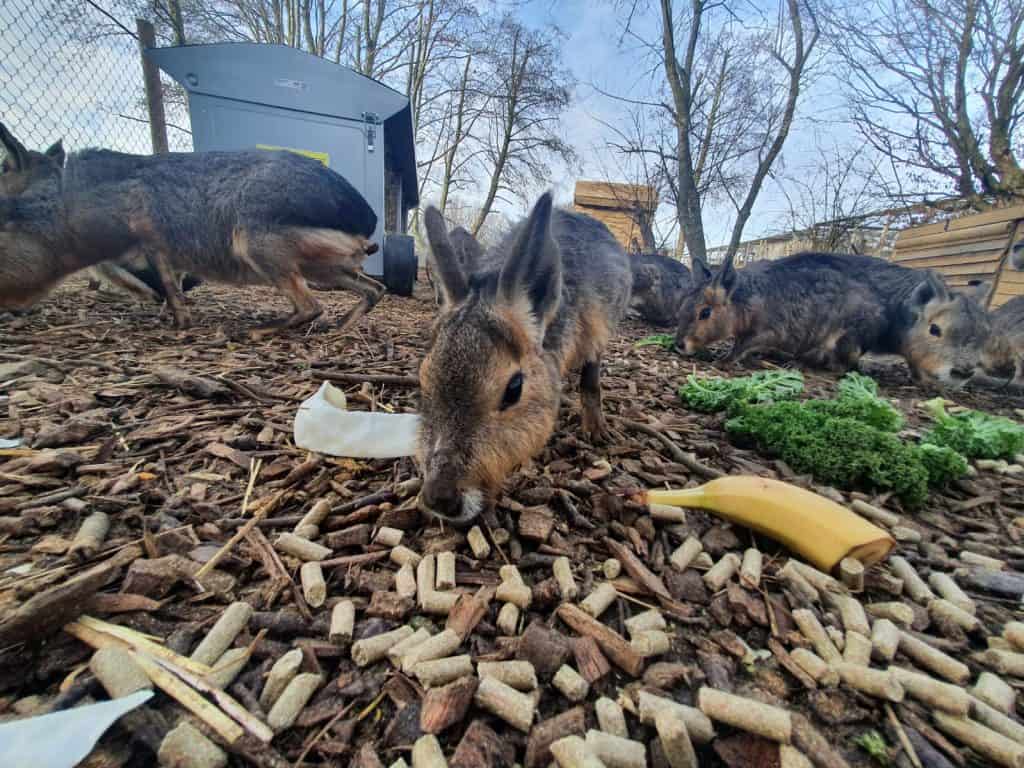Flighty, nervous or shy animals can be quite difficult to train, especially when there is a large group of them. It only takes one of them to set off the whole group.
The keepers need to be able to do a head count in the morning and also a health check daily. If we have animals which are to shy to come near the keepers it can make it much more difficult to do these vital checks. This training also helps them relax and settle into their enclosure.
Every trainer has their own way of doing things and every group of animals is different. However, these are a few methods I have had success with when working with shy animals.
1. Make yourself known
When entering their enclosure or even coming near to their enclosure, I make sure to be saying hello and making them very aware of my presence. No one likes being crept up on! Even if they run away when you talk to them at least you haven’t made them jump.
Giving them a heads up is polite!
2. Get chatting!
I always like to talk continuously during sessions like these to get them used to noise and drown out any potential sudden background noises that may interrupt the session. When they are concentrating on you talking at them they tend to be less nervous and ignore other noises.
3. Timing is key
When I am first starting out with the animals I try to keep the time I go to train with them the same every day. Remember in these cases the animal is nervous of you at the start. If they know roughly what time you will be there they can somewhat prepare themselves for that event. If they don’t know what time you are going to appear that will keep the animals on edge and nervous for more of the day. We want them to be able to relax, giving them some control over what’s happening in their enclosure.
4. Make the connection
I do not spend hours sitting with nervous animals until they become so desperate for food they come near me, for me this is a big no no.
Instead, I take little wins and reward then leave them to it. Remember, removing yourself is also a reward for animals which are nervous. For example, the first session they may run away from you but at a certain distance they will stop and look back. At this point I reward while they are looking at me. Well done you have stopped running from me, reward. Then leave. (double reward!). Once they connect you to the food, you start to see progress.
5. All inclusive
I go as slow as the most nervous or shy individual in the group. This is the one you need to focus on because he or she will be the one that sets off the rest. Make sure that one is getting rewards too, near the back. I also make sure everyone gets their share and there is no fighting for food. I don’t want any negativity associated with these sessions.
6. They make the first move
The ball is in their court whether they want to come closer to you. I do not attempt to approach them, instead I allow them to take a few steps towards me and reward them, and position myself in an area where they have plenty of space to run away if they want to. doing this gives them the control and will earn you their trust.
7. Consistency
This is a big factor. The length of the sessions doesn’t matter it just needs to be done regularly. It will then become part of their routine to come to you for their breakfast, the new normal is what we are aiming for.
8. Team work makes the dream work
It’s no good them only coming over to one person, even if they don’t have the same amount of time as the trainer/ trainers I still try to involve all keepers who enter their enclosure. They can still chat to them while they work around the enclosure, they can still wait for them to stop and look back to give the feed. Once the group is 100% comfortable with me, I will pass it over to the keepers completely.
Case study: Mara recall to trainer
I’m going to use the example of the Mara training that I am currently carrying out with this method as they are a great example of working with shy animals.
We have a group of 13 mara who are fairly new to the park. So, I take into account that I have a group of flighty animals. As well as that everything is new and scary for them at the moment.
To begin with they were quite difficult to headcount as they would run around and hide in several different houses. Which meant that they would have this ‘scary’ experience of trying to avoid the keeper and were only brave enough to emerge from the houses after the food had appeared. So, at this point they had not made the connection between the keeper and food.
So, firstly, I waited for at least the majority of the group to be looking in my direction and not hiding.

At this point I would throw food in front of me. Then I would take a few steps back (rewarding for not running away and rewarding by me stepping away a little). I found that almost immediately after I stepped back, a few came towards me to feed.

Normally in group animals, once a few have checked something out, the rest will then follow. Which is exactly what they did. In the first session they took around 15-20 minutes to all be within 2-3 meters of me.

I repeated this for several sessions at the same time and after about 10 sessions I had all of them within 1 meter of me within 2-3 minutes. Which was very quick progress.

I’m now starting to walk around in front of them, jingling my keys as the keepers would, still chatting away to them and rewarding at the same time.
I’ve found that if you put food down at the same time as standing up/ moving around etc. it distracts them and they ignore and habituate to all these things. So far in trying this, they remain calm and continue eating, some even comfortable to have their back to me!
It’s amazing what difference creating a routine can make!
I am hoping to make a real difference to these shy little characters, build their confidence and watch them fully relax.


